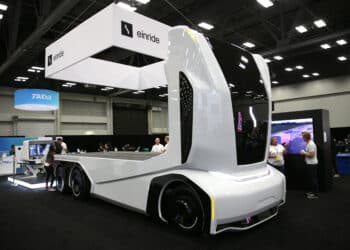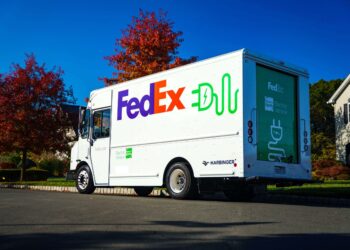Kodiak AI, Aurora Innovation see Q3 growth in autonomous truck market
Autonomous truck market forecasted to reach $1.5T by 2034
Autonomous trucking technology providers Kodiak AI and Aurora Innovation achieved several milestones in the third quarter ahead of potential widespread deployment in 2026.
The global autonomous truck market is projected to more than quadruple to $1.5 trillion in 2034 from $356.9 billion in 2024, according to Global Market Insights. The market continues to build momentum as federal rules, financing models and OEM partnerships take shape, although challenges such as public acceptance and unclear ownership costs remain.
Some year-over-over numbers are not available for Kodiak and Aurora in Q3 because they are early-stage companies focused on product development, testing and partnerships as autonomous freight operations gradually scale throughout the industry.
Kodiak R&D costs swell 29%
Mountain View, Calif.-based Kodiak AI posted $770,000 in revenue in Q3, up 92.5% year over year, according to its Nov. 12 earnings statement, its first since going public in September.
The company’s assets totaled $177.8 million, up 400.1% since the end of 2024. Research and development costs rose 29% YoY to $13.5 million, and operating lease liabilities fell 15.9% YoY to $1.4 million. Kodiak reported a net loss of $269.9 million, compared with a $19.1 million loss in Q3 2024.
At the end of Q3, fleet operators using Kodiak’s self-driving technology logged over 3 million autonomous miles and delivered more than 10,000 loads. Its customers also logged 5,200 cumulative hours of paid driverless operations, a 166% increase from the end of Q2.
Logistics company Atlas Energy Solutions had deployed 10 Kodiak-powered trucks at the end of Q3 as part of a 100-truck order, the “world’s largest known driverless trucking contract,” founder and Chief Executive Don Burnette said during the company’s earnings call.
“Our differentiated technology allows us to seamlessly operate across a variety of environments, giving us the flexibility we need to focus on three large verticals — long-haul trucking, industrial trucking and defense,” he said. “Across these verticals, we work with industry leading customers such as JB Hunt, Werner, CR England, Martin Brower, Atlas Energy Solutions and the U.S. Army.”
Customers pay a recurring fee to use Kodiak’s software as part of its driver-as-a-service (DaaS) model, designed to replicate how freight companies have traditionally paid drivers, Burnette said.
“This DaaS model allows us to generate recurring revenue while keeping our balance sheet relatively asset light,” he said.
Kodiak expects adoption to ramp up in 2026 as it fulfills the Atlas order while benefiting from growing federal support and military investment, Burnette said.
Aurora lease liabilities rise 5%
Pittsburgh-based Aurora Innovation’s revenue totaled $1 million in Q3, matching its Q2 results, according to the company’s Oct. 28 10-Q filing with the SEC.
Aurora’s assets increased 10.8% YoY to $2.5 billion. Operating lease liabilities rose 5% YoY to $21 million, and R&D costs increased 5.9% YoY to $179 million. It posted a net loss of $201 million, compared with a $208 million loss in Q3 2024.
Aurora customers surpassed 100,000 driverless miles on public roads at the end of Q3, with its highest-mileage truck logging nearly 18,000 miles in a single month, co-founder and CEO Christopher Urmson said during the company’s earnings call.
“This demonstrates the confidence we have to operate trucks at an annual run rate that doubles the industry average,” he said. “Our team’s focus has since turned to driverless lane expansion and validation in more challenging weather conditions to further increase the value of the Aurora Driver for our customers.”
The company launched its second driverless route from Fort Worth, Texas, to El Paso, Texas, in Q3 and is nearing extension to Phoenix, Urmson said.
“Looking ahead to 2026, we expect to rapidly unlock lanes across the Sun Belt,” he said. “Future planned expansions include lanes between Dallas and Laredo, a critical route for one of our key customers and between Dallas and Atlanta, which will extend the driverless I-10, I-20 corridor to approximately 2,000 miles.”
Check out our exclusive industry data here.








